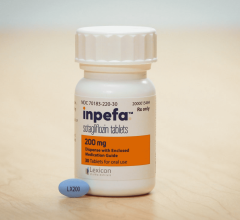A new class of antiplatelet therapy drug pending U.S. Food and Drug Administration (FDA) clearance may offer greater benefits over clopidogrel (Plavix) the current standard of therapy. The new drug also offers the ability to have its effects reversed quickly. In late July, the FDA Cardiovascular and Renal Drugs Advisory Committee voted 7-1 recommending final approval of ticagrelor (Brilinta) for the reduction of thrombotic events in patients with acute coronary syndromes (ACS). While the FDA is not required to follow the approval recommendation from the committee, the agency takes the advice into consideration when rendering its final decisions. The FDA was expected to make a final decision by September, but recently granted an extension until December 16 for further review. According to the PLATO (A Study of PLATelet Inhibition and Patient Outcomes) study of more than 18,000 patients, ticagrelor was superior to clopidogrel in the long-term reduction of cardiovascular events. Data showed ticagrelor reduced cardiovascular death, heart attacks and stroke over clopidogrel (9.8 vs. 11.7 percent), without an increase in overall major bleeding (11.6 vs. 11.2 percent). Unlike clopidogrel or prasugrel (Effient), approved a year ago, ticagrelor is the first reversible oral antiplatelet drug. This may offer benefits for patients who need to undergo surgery or suffer trauma. Current protocols usually call for patients to stop taking clopidogrel several days prior to surgery to prevent major bleeding complications. Meaningful Use Finally Defined The 2009 Health Information Technology for Economic and Clinical Health Act of 2009 (HITECH), part of the federal stimulus package, was supposed to inject more than $20 billion into healthcare information technology (IT). However, a year, later very little of that money has been spent because the government stipulated that funds should only be used for technology meeting the nebulous definition of “meaningful use.” In July, final meaningful use regulations were announced by the Centers for Medicare and Medicaid (CMS) and the Office of the National Coordinator for Health Information Technology (ONC). These rules define the incentive payments program attached to healthcare technology. The rules also outlined standards and certification requirements for electronic medical record (EMR) systems. The goal of HITECH is to achieve widespread adoption of EMRs by 2014. CMS will administer an incentive payments program that will make significant bonus payments available to eligible healthcare providers who adopt and demonstrate meaningful use of certified EMRs. For details and a complete listing of the new regulations, visit the U.S. Department of Health and Human Services health IT site at: http://healthit.hhs.gov/portal/server.pt?open=512&objID=2996&mode=2. Sorry about the long link, but it is the federal government after all. Included in this issue of Diagnostic and Interventional Cardiology is a comparison chart for cardiovascular information systems (CVIS) and cardiovascular picture archiving and communications systems (PACS), starting on page 5. There has been a big question among healthcare IT vendors as to how meaningful use would effect their products. However, all the large healthcare vendors have given commitments to their customers that they will provide whatever is needed to meet any new federal requirements – as if they have a choice in the matter if they want to stay in business. Hybrid Planning Needs Clinical Engineers The July/August issue of DAIC included a story about what is needed when planning a hybrid cath lab/operating room. Frank E. Nickells Jr., CBET, clinical engineering support manager, CHI/Centura Health Supply Chain Management, responded to the story and said clinical engineers were missing on a list of key players to include on a planning committee. He wrote, “All key persons listed are necessary, but clinical engineering is at least as important as facilities engineering. Facilities engineering is important for planning this venture, but clinical engineers will live with and support this product for the next seven to 10 years through either direct support or contract support.” Nickells said facility engineers do not affect down-time and revenue generation during the hybrid’s operational life, whereas clinical engineers do. He said they also should be involved in the purchasing phase of the project. The Web link to last month’s story on how to plan for a hybrid lab installation can be found at www.dicardiology.net/node/37175.
If you enjoy this content, please share it with a colleague
New Antiplatelet Drug May Offer Benefits Over Clopidogrel
Related Content
July 10, 2024 — Reviva Pharmaceuticals Holdings, Inc., a late-stage pharmaceutical company developing therapies that ...
June 5, 2024 — Lexicon Pharmaceuticals, Inc. (Nasdaq: LXRX) today announced a new post-hoc analysis of clinical data ...
May 24, 2024 — Lexicon Pharmaceuticals, Inc. announced a new post-hoc analysis of clinical data showing that INPEFA ...
May 6, 2024 — Tenax Therapeutics, Inc., a Phase 3, development-stage pharmaceutical company focused on identifying ...
February 16, 2024 — AMO Pharma Limited, a privately held clinical-stage specialty biopharmaceutical company focusing on ...
January 25, 2024 — Agepha Pharma, a leading multinational pharmaceutical company with the first FDA-approved anti ...
January 12, 2024 — BridgeBio Pharma, Inc., a commercial-stage biopharmaceutical company focused on genetic diseases and ...
November 21, 2023 — BridgeBio Pharma, Inc., a commercial-stage biopharmaceutical company focused on genetic diseases and ...
In a new 3-part video series on hypertrophic cardiomyopathy with Christine E. Seidman, MD, FACC, FAHA, Managing Editor ...
In this third and final segment in DAIC’s “One on One” series with Dr. Christine Seidman, learn what’s on the horizon at ...


 July 10, 2024
July 10, 2024 








